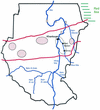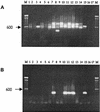Environmental occurrence of Madurella mycetomatis, the major agent of human eumycetoma in Sudan
- PMID: 11880433
- PMCID: PMC120253
- DOI: 10.1128/JCM.40.3.1031-1036.2002
Environmental occurrence of Madurella mycetomatis, the major agent of human eumycetoma in Sudan
Abstract
Madurella mycetomatis is the main causative agent of human eumycetoma, a severe debilitating disease endemic in Sudan. It has been suggested that eumycetoma has a soil-borne or thorn prick-mediated origin. For this reason, efforts were undertaken to culture M. mycetomatis from soil samples (n = 43) and thorn collections (n = 35) derived from areas in which it is endemic. However, ribosomal sequencing data revealed that the black fungi obtained all belonged to other fungal species. In addition, we performed PCR-mediated detection followed by restriction fragment length polymorphism (RFLP) analysis for the identification of M. mycetomatis DNA from the environmental samples as well as biopsies from patients with mycetoma. In the case of the Sudanese soil samples, 17 out of 74 (23%) samples were positive for M. mycetomatis DNA. Among the thorn collections, 1 out of 22 (5%) was positive in the PCR. All PCR RFLP patterns clearly indicated the presence of M. mycetomatis. In contrast, 15 Dutch and English control soil samples were all negative. Clinically and environmentally obtained fungal PCR products share the same PCR RFLP patterns, suggesting identity, at least at the species level. These observations support the hypothesis that eumycetoma is primarily environmentally acquired and suggest that M. mycetomatis needs special conditions for growth, as direct isolation from the environment seems to be impossible.
Figures



References
-
- Abbott, P. 1956. Mycetoma in the Sudan. Trans. R. Soc. Trop. Med. Hyg. 50:11-30. - PubMed
-
- Ahmed, A. O. A., M. M. Mukhtar, M. Kool-Sijmons, A. H. Fahal, G. S. De Hoog, A. H. G. Gerrits van den Ende, E. E. Zijlstra, H. Verbrugh, A. M. El Sir Abugroun, A. M. Elhassan, and A. Van Belkum. 1999. Development of a species-specific PCR-restriction fragment length polymorphism analysis procedure for identification of Madurella mycetomatis. J. Clin. Microbiol. 37:3175-3178. - PMC - PubMed
-
- Basset, A., R. Camain, R. Baylet, and D. Lambert. 1965. Role des épines de mimosacées dans l'inoculation des mycétomes (à propos de deux observations). Bull. Soc. Pathol. Exot. 58:22-24. - PubMed
-
- Brumpt, E. 1906. Les mycétomes. Asselin & Houzeau, Paris, France.
-
- De Hoog, G. S., A. Buiting, C. S. Tan, A. B. Stroebel, C. Ketterings, E. J. De Boer, B. Naafs, R. Brimicombe, M. K. E. Nohlmans-Paulssen, G. T. J. Fabius, A. H. Klokke, and L. G. Visser. 1993. Diagnostic problems with imported cases of mycetoma in The Netherlands. Mycoses 36:81-87. - PubMed
Publication types
MeSH terms
Substances
LinkOut - more resources
Full Text Sources

